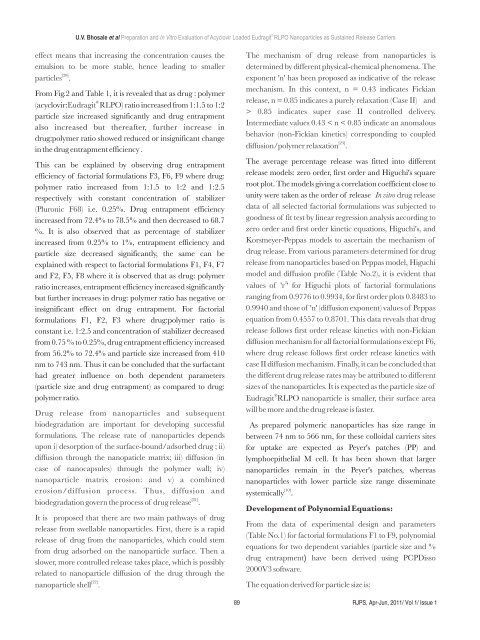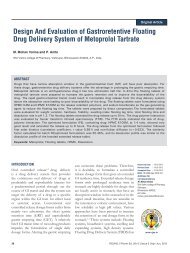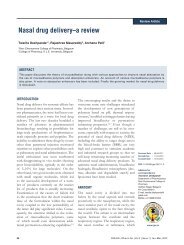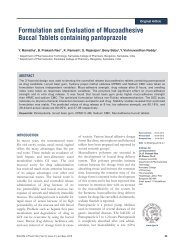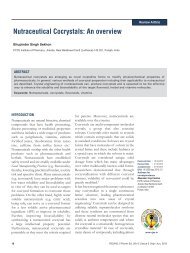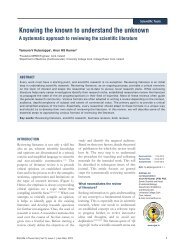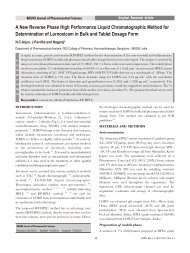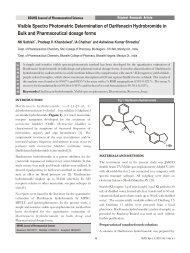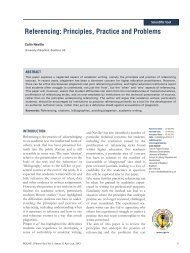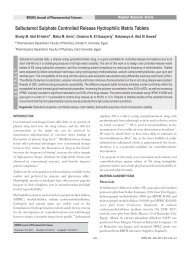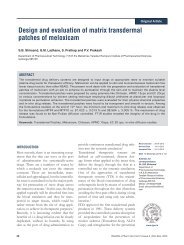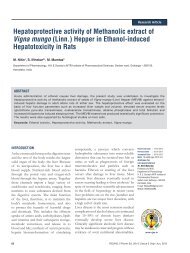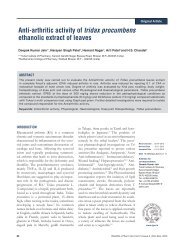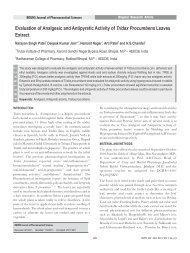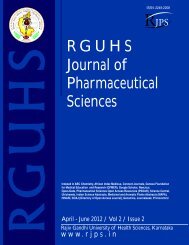final .cdr
final .cdr
final .cdr
You also want an ePaper? Increase the reach of your titles
YUMPU automatically turns print PDFs into web optimized ePapers that Google loves.
®<br />
U.V. Bhosale et al Preparation and In Vitro Evaluation of Acyclovir Loaded Eudragit RLPO Nanoparticles as Sustained Release Carriers<br />
effect means that increasing the concentration causes the<br />
emulsion to be more stable, hence leading to smaller<br />
[20]<br />
particles .<br />
From Fig.2 and Table 1, it is revealed that as drug : polymer<br />
®<br />
(acyclovir: Eudragit RLPO)<br />
ratio increased from 1:1.5 to 1:2<br />
particle size increased significantly and drug entrapment<br />
also increased but thereafter, further increase in<br />
drug:polymer ratio showed reduced or insignificant change<br />
in the drug entrapment efficiency .<br />
This can be explained by observing drug entrapment<br />
efficiency of factorial formulations F3, F6, F9 where drug:<br />
polymer ratio increased from 1:1.5 to 1:2 and 1:2.5<br />
respectively with constant concentration of stabilizer<br />
( Pluronic F68) i.e. 0.25%. Drug entrapment efficiency<br />
increased from 72.4% to 78.5% and then decreased to 68.7<br />
%. It is also observed that as percentage of stabilizer<br />
increased from 0.25% to 1%, entrapment efficiency and<br />
particle size decreased significantly, the same can be<br />
explained with respect to factorial formulations F1, F4, F7<br />
and F2, F5, F8 where it is observed that as drug: polymer<br />
ratio increases, entrapment efficiency increased significantly<br />
but further increases in drug: polymer ratio has negative or<br />
insignificant effect on drug entrapment. For factorial<br />
formulations F1, F2, F3 where drug:polymer ratio is<br />
constant i.e. 1:2.5 and concentration of stabilizer decreased<br />
from 0.75 % to 0.25%, drug entrapment efficiency increased<br />
from 56.2% to 72.4% and particle size increased from 410<br />
nm to 743 nm. Thus it can be concluded that the surfactant<br />
had greater influence on both dependent parameters<br />
(particle size and drug entrapment) as compared to drug:<br />
polymer ratio.<br />
Drug release from nanoparticles and subsequent<br />
biodegradation are important for developing successful<br />
formulations. The release rate of nanoparticles depends<br />
upon i) desorption of the surface-bound/adsorbed drug ; ii)<br />
diffusion through the nanopaticle matrix; iii) diffusion (in<br />
case of nanocapsules) through the polymer wall; iv)<br />
nanoparticle matrix erosion: and v) a combined<br />
erosion/diffusion process. Thus, diffusion and<br />
[21]<br />
biodegradation govern the process of drug release .<br />
It is proposed that there are two main pathways of drug<br />
release from swellable nanoparticles. First, there is a rapid<br />
release of drug from the nanoparticles, which could stem<br />
from drug adsorbed on the nanoparticle surface. Then a<br />
slower, more controlled release takes place, which is possibly<br />
related to nanoparticle diffusion of the drug through the<br />
[22]<br />
nanoparticle shell .<br />
89<br />
The mechanism of drug release from nanoparticles is<br />
determined by different physical-chemical phenomena. The<br />
exponent 'n' has been proposed as indicative of the release<br />
mechanism. In this context, n = 0.43 indicates Fickian<br />
release, n = 0.85 indicates a purely relaxation (Case II) and<br />
> 0.85 indicates super case II controlled delivery.<br />
Intermediate values 0.43 < n < 0.85 indicate an anomalous<br />
behavior (non-Fickian kinetics) corresponding to coupled<br />
[23]<br />
diffusion/polymer relaxation .<br />
The average percentage release was fitted into different<br />
release models: zero order, first order and Higuchi's square<br />
root plot. The models giving a correlation coefficient close to<br />
unity were taken as the order of release In vitro drug release<br />
data of all selected factorial formulations was subjected to<br />
goodness of fit test by linear regression analysis according to<br />
zero order and first order kinetic equations, Higuchi's, and<br />
Korsmeyer-Peppas models to ascertain the mechanism of<br />
drug release. From various parameters determined for drug<br />
release from nanoparticles based on Peppas model, Higuchi<br />
model and diffusion profile (Table No.2), it is evident that<br />
2<br />
values of 'r ' for Higuchi plots of factorial formulations<br />
ranging from 0.9776 to 0.9934, for first order plots 0.8483 to<br />
0.9940 and those of 'n' (diffusion exponent) values of Peppas<br />
equation from 0.4557 to 0.8701. This data reveals that drug<br />
release follows first order release kinetics with non-Fickian<br />
diffusion mechanism for all factorial formulations except F6,<br />
where drug release follows first order release kinetics with<br />
case II diffusion mechanism. Finally, it can be concluded that<br />
the different drug release rates may be attributed to different<br />
sizes of the nanoparticles. It is expected as the particle size of<br />
®<br />
Eudragit RLPO nanoparticle is smaller, their surface area<br />
will be more and the drug release is faster.<br />
As prepared polymeric nanoparticles has size range in<br />
between 74 nm to 566 nm, for these colloidal carriers sites<br />
for uptake are expected as Peyer's patches (PP) and<br />
lymphoepithelial M cell. It has been shown that larger<br />
nanoparticles remain in the Peyer's patches, whereas<br />
nanoparticles with lower particle size range disseminate<br />
[10]<br />
systemically .<br />
Development of Polynomial Equations:<br />
From the data of experimental design and parameters<br />
(Table No.1) for factorial formulations F1 to F9, polynomial<br />
equations for two dependent variables (particle size and %<br />
drug entrapment) have been derived using PCPDisso<br />
2000V3 software.<br />
The equation derived for particle size is:<br />
RJPS, Apr-Jun, 2011/ Vol 1/ Issue 1


